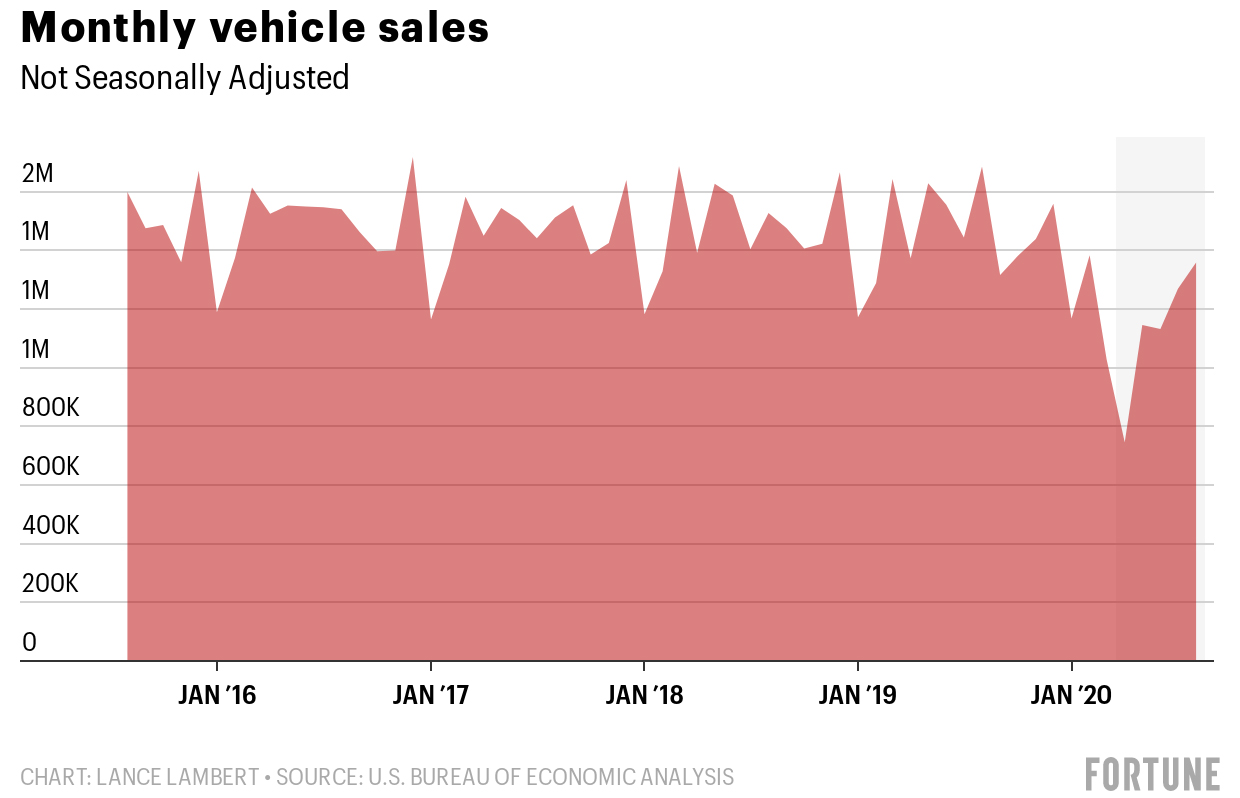美国春季汽车销量暴跌,导致装运场车辆积压,运输新车的货轮只能在海上漂泊数周。由于销量低迷和全国停工,福特汽车(Ford Motor)和通用汽车(General Motors)等厂商都关闭了生产线。
汽车行业的另一场危机似乎已经来临。
但在8月,汽车月销量达到近140万辆,与2月新冠肺炎疫情之前的销量相当,是4月销量(745,353辆)的近两倍。这就是所谓的V字型反弹。
反弹的速度之快导致新车和二手车迅速从供应过剩变成了供应短缺,进而推高了汽车售价。据Edmunds.com网站统计,8月新车平均售价为39,410美元,比5月上涨了807美元。8月二手车平均售价为21,843美元,比5月上涨了920美元。

美国全国汽车经销商协会(National Automobile Dealers Association)的公关副总裁贾里德•艾伦说:“第二季度,所有大型汽车厂商全部停工,这是自二战以来首次出现这种情况,并造成了今天的库存短缺。除此之外,新车库存短缺促使许多购车人选择了同样供不应求的二手车市场。结果就是二手车的价格也大幅上涨。”
经济状况的改善和美国老年人在疫情期间尽量避免公共交通,正在增加汽车经销商的销量。市场分析机构Wards Intelligence表示,销售的火爆也导致新车库存创下八年来的最低水平。
汽车产量什么时候能够恢复正常?
艾伦表示:“我们预计这种情况是临时的……不考虑因为新冠肺炎疫情导致的零部件意外延误或汽车工厂停工,预计汽车库存将很快接近正常水平。”除了汽车以外,春季的停工和夏季的需求激增,导致美国经济普遍面临物资短缺。从木材、硬币、弹药、牛肉到医疗用品,都受到了影响。
对于消费者来说,供应不足会导致价格上涨,但好的一面是,这意味着制造商将获得大量业务。(财富中文网)
翻译:刘进龙
审校:汪皓
美国春季汽车销量暴跌,导致装运场车辆积压,运输新车的货轮只能在海上漂泊数周。由于销量低迷和全国停工,福特汽车(Ford Motor)和通用汽车(General Motors)等厂商都关闭了生产线。
汽车行业的另一场危机似乎已经来临。
但在8月,汽车月销量达到近140万辆,与2月新冠肺炎疫情之前的销量相当,是4月销量(745,353辆)的近两倍。这就是所谓的V字型反弹。
反弹的速度之快导致新车和二手车迅速从供应过剩变成了供应短缺,进而推高了汽车售价。据Edmunds.com网站统计,8月新车平均售价为39,410美元,比5月上涨了807美元。8月二手车平均售价为21,843美元,比5月上涨了920美元。
美国全国汽车经销商协会(National Automobile Dealers Association)的公关副总裁贾里德•艾伦说:“第二季度,所有大型汽车厂商全部停工,这是自二战以来首次出现这种情况,并造成了今天的库存短缺。除此之外,新车库存短缺促使许多购车人选择了同样供不应求的二手车市场。结果就是二手车的价格也大幅上涨。”
经济状况的改善和美国老年人在疫情期间尽量避免公共交通,正在增加汽车经销商的销量。市场分析机构Wards Intelligence表示,销售的火爆也导致新车库存创下八年来的最低水平。
汽车产量什么时候能够恢复正常?
艾伦表示:“我们预计这种情况是临时的……不考虑因为新冠肺炎疫情导致的零部件意外延误或汽车工厂停工,预计汽车库存将很快接近正常水平。”除了汽车以外,春季的停工和夏季的需求激增,导致美国经济普遍面临物资短缺。从木材、硬币、弹药、牛肉到医疗用品,都受到了影响。
对于消费者来说,供应不足会导致价格上涨,但好的一面是,这意味着制造商将获得大量业务。(财富中文网)
翻译:刘进龙
审校:汪皓
Car sales plummeted in the spring, causing shipment lots to overfill and forcing cargo ships to hold new vehicles at sea for weeks. And with few sales and facing state shutdown orders, auto manufacturers like Ford Motor and General Motors halted production lines.
It was starting to look like another automotive crisis.
But fast-forward to August, where monthly vehicle sales were nearly 1.4 million—matching pre-pandemic sales of February and almost double the 745,353 vehicle sales in April. That's what you call a V-shaped recovery.
The rebound was so fast that new and used vehicles skipped right from oversupply to shortage—which is driving up prices. The average list price of new vehicles in August is $39,410, up $807 from May, according to Edmunds.com. While the average price in August for used vehicles is $21,843, up $920 from May.
"In the second quarter, every major auto manufacturer shut down production—for the first time since World War II—which led to inventory shortages that are still being felt today," Jared Allen, vice president of communications of the National Automobile Dealers Association told Fortune. "On top of that, the shortage of new-vehicle inventory has pushed many buyers to the used-car market, where supply is also low. The result is a significant increase in prices for used vehicles, as well."
The combination of an improved economy—and older Americans trying to avoid public transportation during the pandemic—is driving up sales at auto dealerships. And it's pushed inventory numbers for new vehicles to an eight-year low, according to Wards Intelligence.
When will auto production catch back up?
"We expect this to be temporary ... barring any unexpected parts delays or vehicle plant shutdowns stemming from new COVID-19 outbreaks, we expect that vehicle inventory levels will be at close to normal levels," Allen says. Beyond cars, the economy at large is facing widespread shortages caused by the production shutdowns in the spring and resurgent demand in the summer. Everything from lumber, coins, ammo, beef, to medical supplies has been affected.
Shortages might bring higher prices for consumers, but on the flip side it means plenty of business for manufacturers.






